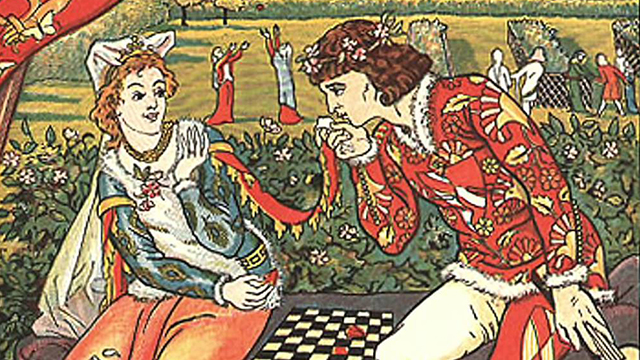Know the Basics: The Medieval Plays
Written by Ashleigh Gardner
May 22, 2017
The Medieval period was an influential time in the history of theatre. While these productions weren’t as grand as your high school musical, they brought people together in droves. Get thee to a library (or Project Gutenberg) to check out these plays before you get into Shakespeare.
The plays of Hrotsvitha (10th century)
Hrotsvitha (pronounced “rose-VIT-a”) was a 10th century German secular canoness, dramatist, and poet and is considered the first person since antiquity to compose drama in the Latin-speaking/writing West. Her plays Gallicanus (how Emperor Constantine’s daughter tricks her suitor to convert to Christianity) and Dulcitius (a man becoming so enamored of women that he gets a little delusional and makes out with some pots and pans in the kitchen) are some of the earliest examples of Medieval drama and comedy.
Oro Virtutum by Hildegard of Bingen (1155 A.D.)
Hildegard was a canoness, poet, dramatist, and scientist. Arguably the oldest surviving morality play and an early example of liturgical drama, her play Oro Virtutum is the struggle for the human Soul between Virtues and the Devil. A happy Soul enters and is greeted by Virtues, and while she is eager to skip life and get into heaven, the Virtues tell her she must live first. The Soul is then seduced by the Devil. After the Virtues present their case to the Soul, she returns to them. The girl and the Virtues bind the Devil and present him to God. In 1998, Twin Peaks and Eraserhead director David Lynch teamed up with violinist Jocelyn Montgomery and created an album based on Hildegard’s verse in Oro Virtutum called Lux Vivens. Listen to the music above.
Jeu de Robin et Marion by Adam de la Halle (1282/1283 A.D.)
The story is a dramatization of a type of medieval French song called a pastourelle, a song that usually depicts a knight approaching a shepherdess with desires of romance. Though the title looks like it might be the story of Robin Hood and Maid Marian, it’s not exactly that, and there is no proof that the stories are connected. The story goes that Marion, a shepherdess, is approached by a persistent knight who proposes marriage to her. The action takes place around Marion, her lover Robin, and their friends as Marion continuously rejects the knight’s advances.
The Interlude of the Student and the Girl (1300 A.D.)

In this comedy, a young student tries to woo a girl he’s fallen in love with. After the girl’s parents leave the house, the student sneaks in and declares his love for her and tries to convince her to marry him. She heartily rejects him, and so the student attempts to enlist the help of Mother Eloise, an old woman close to the girl’s family. The student offers Eloise money if she will talk to the girl and convince her to marry the student. Eloise, too, rejects the student and proclaims that she is above such deceitful actions.
Everyman (late 15th century)
One of the most famous morality plays of the Middle Ages, Everyman is taught in theatre classes all over the world. Everyman is an allegorical story about Everyman, a character who represents all mankind. Over the course of the play, Everyman encounters different characters who tempt, insult, and shun him — all except Good Deeds. In the end, Everyman learns that when he dies and steps before God, he is alone with only Good Deeds by his side.
Liturgical plays (12th century – 1550 A.D.)
Economic changes during the High Middle Ages resulted in the creation of guilds for workers with specialized trades. Trade guilds began to perform religious plays, and each guild would be responsible for one of the stories from the Bible. For example, the Baker’s Guild would perform The Last Supper and the Barbers would perform the Baptism of Jesus. Mystery plays were performed in large cycles of stories with 24 plays, 32 plays, and 48 plays depending on the area of the country that staged them. These plays were staged on pageant wagon stages with wheels that were easily moved from town to town. Actors in England during this time were exclusively male, but other countries allowed female performers. The Morality plays of this time stemmed from the Mystery plays, as did small dramas like Nativity (birth of Jesus), Passion plays (crucifixion of Jesus), and Easter dramas (resurrection of Jesus).
Unfortunately, the Protestant Reformation caused theatre to take a hit. The Protestant church criticized pageant plays for their allegiance to Catholic dogma and shut down many of them. The Council of Trent, a Catholic council, also banned pageant plays because the Catholic church was tired of Protestant influence in the way pageant plays were performed. Fortunately, theatre made a comeback when wealthy educated people began to call for Greek and Roman plays to be staged. This led the way for the creation of commedia dell’arte and was the start of Renaissance theatre.
Interested in theatre history? Check out our other features below!
- 25 Plays all High School Seniors Should Read (Before They Graduate)
- 10 Contemporary LGBT Playwrights You Should Know
- 10 Contemporary Native American Playwrights You Should Know
- 10 Contemporary Playwrights of Color You Should Know
- 10 Asian American Playwrights You Should Know
- 10 Latinx, Hispanic, and Chicano/a Playwrights You Should Know
- 10 Eighteenth-Century Female Playwrights You Should Know
- 10 Nineteenth-Century Female Playwrights You Should Know
- 10 Classic Russian Playwrights You Should Know
- 12 Elizabethan and Jacobean Playwrights You Should Know
- 7 Greek and Roman Playwrights You Should Know
- 13 Classic American Playwrights You Should Know
- Early 20th Century Broadway Composers and Lyricists You Should Know
